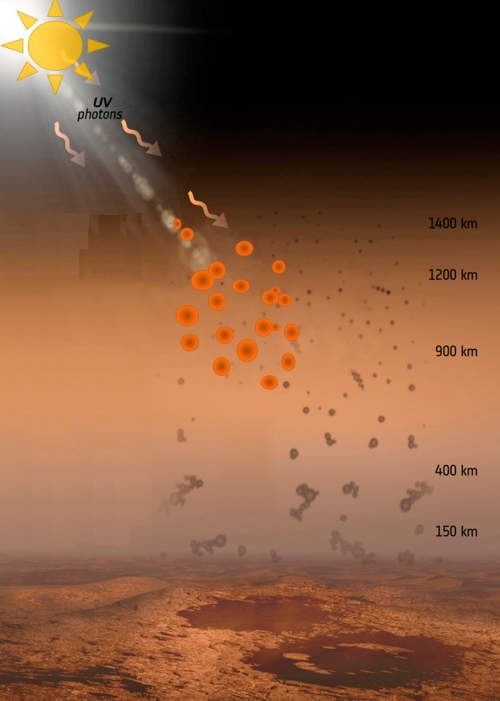An international scientific consortium, led by teams from the LATMOS and DESIRS beamline, extends the legacy and impact of the Cassini-Huygens mission into the laboratory. During 13 years, the Cassini spatial probe and its airborne set of instruments have been continuously observing the giant Saturn and its icy moons, notably Titan. This satellite possesses an atmosphere quite similar to ours. The scientists discovered that nanometric haze grains are therefore formed in Titan’s upper atmosphere, are chemically processed by the solar radiation – they are aging! – then slowly dive into deeper layers of the atmosphere. Since the Titan’s haze is abundant, the impact of the photochemical processing into Titan’s climate should be taken into account. This issue is addressed in an article published on April 9th in Nature Astronomy.
Titan is mainly composed of nitrogen and enjoying a chaotic weather: rains, clouds and photochemical haze. This false-twin has also its own characteristics: a freezing temperature of -180°C, and the absence of oxygen and water. Methane, a small hydrocarbon (CH4), is ubiquitous both as a liquid and a gas. Under solar radiations, it reacts with nitrogen (N2) leading to large organic molecules, precursors of elementary bricks of the living world that we know. In this sense, Titan is an open-sky reactor for the formation of prebiotic molecules, whose genesis and evolution is a cornerstone of astrobiology, a broad cross-disciplinary field studying the origin of life.
Scientists from the LATMOS and DESIRS beamline have experimentally simulated Titan’s atmosphere in order to better understand its chemistry and to answer some issues raised by the mission. Indeed, Cassini revealed that chemistry would be triggered very high up in the atmosphere of Titan. Nanometric solid grains appear at an altitude of more than 1000 km. These grains, by an aggregation process, grow and fall in the atmosphere constituting the orange haze surrounding Titan. But, at such a high altitude, as on Earth, these grains, also called aerosols, are submitted to the intense and barely-filtered UV radiation from the Sun. What happens to these haze grains under the effect of such energetic UV photons?Researchers started by synthesizing grains analogs (the aerosols) in a reactor which simulates the chemistry of nitrogen and methane in proportions representative of Titan’s atmosphere. Then they chose the artificial sun which mimics the best the spectrum found in Titan’s upper atmosphere, the UV photons delivered by the DESIRS beamline at Synchrotron SOLEIL, to irradiate films of aerosol analogs in the far UV, at several wavelengths.

Artist view of Titan’s haze grains irradiation by solar UV photons (figure adapted from Waite et al. Science 2007) (c) ESA
Then they monitored, as a function of the irradiation duration, their chemical signatures by infra-red spectroscopy and inferred that the haze grains were losing some of their hydrogen contain while remaining nitrogen-rich. A day in Titan appears therefore quite busy!
Such clear photochemical changes might explain the apparent contradiction between measurements performed at high altitude and on Titan’s surface via different Cassini-Huygens instruments.
Scientists also hope that a new mission will be launched soon towards Titan in order to observe in situ such a phenomenon.
This work was financially supported by the ERC-starting grant PrimChem (No. 636829).
